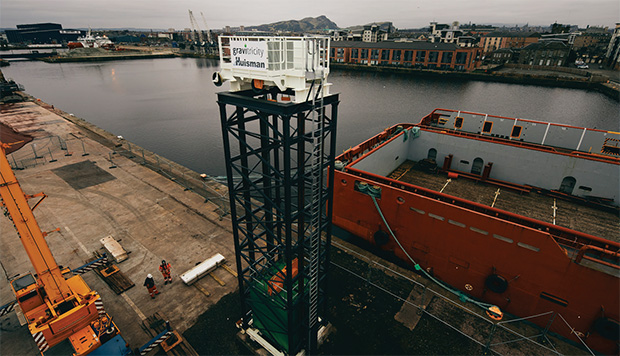Energy storage specialist Gravitricity has submitted a global patent to turn underground shafts into pressurised energy stores capable of safely accumulating significant quantities of hydrogen gas. The solution would be coupled to its short duration quick response gravity-based energy storage system, with a green fuel-gas solution for longer feed-in durations or to refuel heavy goods vehicles, ships or trains.
Click to download and read pdf
 Describing Gravitricity’s core technology, MD Charlie Blair says that, in principle, it is similar to pumped-storage technology, but with very different mechanical characteristics. “Instead of pumping water up into a high level dam so that it can be run back down into the pump-turbines below, a heavy weight in a mine shaft is connected to a winch and generator system. The weight is raised by the motor using green, surplus or inexpensive power. When additional power is needed to balance the grid, the weight is dropped back down into the shaft, causing the motor to operate as an electricity generator.
Describing Gravitricity’s core technology, MD Charlie Blair says that, in principle, it is similar to pumped-storage technology, but with very different mechanical characteristics. “Instead of pumping water up into a high level dam so that it can be run back down into the pump-turbines below, a heavy weight in a mine shaft is connected to a winch and generator system. The weight is raised by the motor using green, surplus or inexpensive power. When additional power is needed to balance the grid, the weight is dropped back down into the shaft, causing the motor to operate as an electricity generator.
“We lower a weight to discharge stored energy and we raise the weight again to recharge the energy store. It is just like a giant rechargeable battery that stores and then releases electrical energy, using gravitational potential energy for storage instead of chemical energy,” he explains, adding that Gravitricity has built a concept model on a 15 m tower that uses a 50 t weight to store and release 250 kW.
The mine shaft infrastructure of depleted underground mines is ideal for rolling out commercial installations of this technology, giving these sites a renewed purpose. “The investment returns are easily justified, because every aspect of the technology has a very long life: we can easily guarantee 25 plus years of energy storage from a Gravitricity system,” says Blair.
Energy storage saves at the very highest costs of generation systems, because it enables a local energy grid to be sized and operated based on average rather than peak demand. “Wind and solar are difficult to dispatch, but we know that PV-battery storage and other solutions make the transition to renewables possible. The question is how do we do it as cheaply and effectively as possible.
“We believe that long-life energy storage is key to the effectiveness of the transition, so our technology is very different to battery storage technology because it has a cycle life of up to 100 times longer,” notes Blair.
Initially, to reduce costs and risks, the use of redundant mine infrastructure is clearly sensible. “There is a pull from the end-of life mine operators who want to be seen to be doing responsible things with their ageing infrastructure. For coal mines in Czechia and Poland for example, the European Commission (EC) is supporting the deployment of Gravitricity solutions, because their mines are closing due to EC legislation. In South Africa, the mine operators are faced with land reclamation and remediation costs. At the same time, there is pressure to support the ailing grid, so adding a real long-term solution such as Gravitricity is a good-fit solution,” suggests Blair.
He says that Gravitricity currently has a pipeline of some 50 shafts around the world that are interested in the technology, several of which are in South Africa. “These are €10-million projects so it takes time to reach financial closure, but we do have interested mine operators from South Africa and across Africa. Some are interested in using the stored power for themselves, while others are simply looking to find new uses for their infrastructure, in which case a build-own-operate model may emerge with development partners taking on the investment based on PPA type contracts.
He goes on to say that one of Gravitricy’s partners, RESA, is currently building many hundreds of MW of solar power across southern Africa and, for these, tens of MW of storage is needed. “They are not fussy about where the storage is located, either, as long as it is connected to the same grid,” says Blair.
The addition of hydrogen storage
Gravitricity’s founder, Martin Wright says the future hydrogen economy will need to find economic and safe ways to store hydrogen where it’s needed. “At present our domestic gas network in the UK has vast amounts of storage built in, under the North Sea. The gas grid of the future will be powered by intermittent renewables and that means we need to find ways to store green hydrogen when energy is plentiful, close to where it’s required.
“Our idea is to make each Gravitricity shaft serve as a very large, sealed pressure vessel and to use the shaft itself to hold significant quantities of gas. We believe this will be far more economic and safer than above-ground storage pressure vessels, and it will massively increase the storage capacity of the system.
Wright envisages building single or multiple shafts which, when co-located with a green hydrogen electrolysis plant, would have a very clear dual function: to store excess electricity for use by the electrolysers when needed, and to store the plant’s output as a buffer into the gas grid. This will not only smooth the input and output of the green hydrogen plant, but it will improve the economics, bringing down the cost of green hydrogen.
“The hydrogen store could also be used as a fuelling point, providing low (or zero) carbon hydrogen fuel for heavy goods vehicles, ships or trains: or it could be used to generate significant additional quantities of electricity if required,” Wright says.
Further explaining how the two technologies complement each other, Blair says that gravity-based energy storage is very good for second by second, minute by minute or hour by hour energy management: it can rapidly respond to generation shortfalls and feed power into a grid to balance demand for shorter durations. “Any shortfall within the same day can be accommodated,” he says.
To fill in for longer periods, a fuel gas solution is generally required. “That’s where we see hydrogen coming in. We could of course also store bio-gas or even natural gas, but the basic idea is to use the structure and geology of the same shaft being used to lower and raise the weight to store pressurised hydrogen,” he says.
“Renewable energy generation is already creating periods of surpluses of energy, which is causing wind farms, for example, to be underutilised. The readily dispatchable generators on a grid, such as coal-fired and nuclear power generation, cannot be easily ramped up or down to follow demand, so grid connected wind turbines are routinely being turned off to keep the grid balanced.
“Instead of turning these turbines off, we believe surplus electricity could be redirected into hydrogen electrolysers to make ‘free’ hydrogen fuel instead of wasting the generation capacity. It may never make sense to put all of that hydrogen back into electricity, but hydrogen is also an ideal green fuel,” he explains.
Initially, he suggests, Gravitricity’s hydrogen storage technology is likely to be implemented in new-shaft projects in Europe, where high pressure sealing can be incorporated during the initial construction. “It is obviously harder to create a pressure seal in an existing mine because there are side shafts from the mine workings, for example, but it’s definitely possible and still not as cost intensive as sinking a new shaft from scratch,” he adds.
In Africa, own power use is also more common, Blair suggests. “Solar power plants operated on an islanded off-grid basis are of particular interest to us and we have a short-list of facilities we are investigating with respect to operating gravity- and hydrogen-based storage plants using onsite solar panels,” he says.
“Between Martin Wright, myself and our other business partner, Peter Fraenkel, we have well over 50 years of experience in clean energy, storage and transition. This is our passion, to balance the power grid to make clean and renewable energy generation more dispatchable and, in so doing, to create an affordable and stable energy transition,” Blair concludes.













